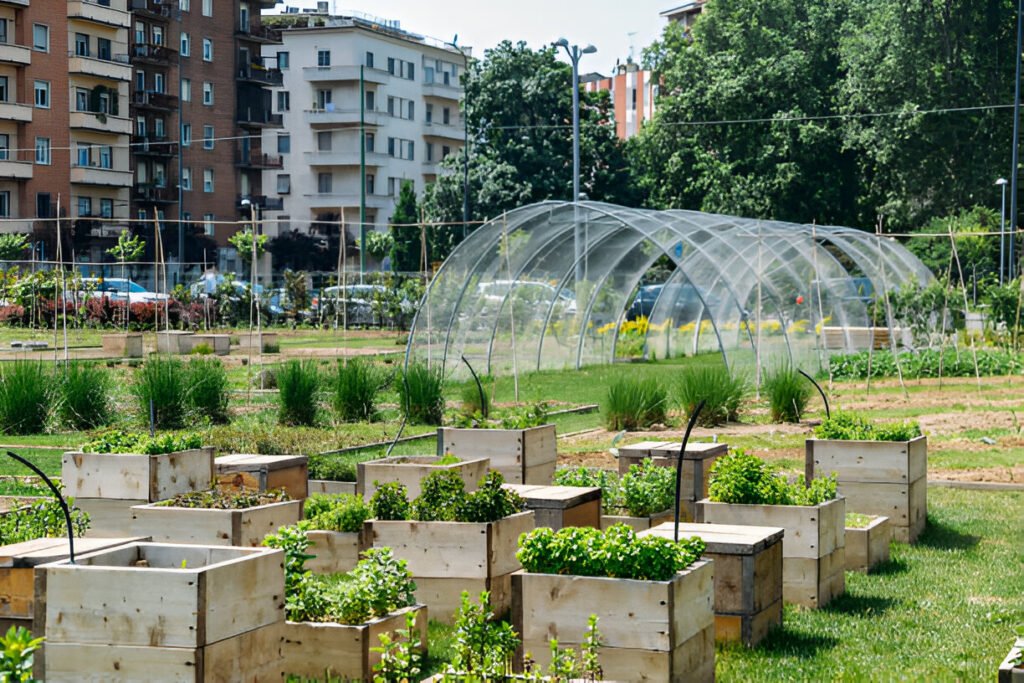Urban gardening is more than just a trend—it’s a way to bring nature into your everyday life, even if you’re living in a bustling city. With limited outdoor space, many people feel gardening is out of reach, but that couldn’t be further from the truth. Whether you have a small balcony, rooftop, or windowsill, creating a garden at home is achievable and deeply rewarding. Let’s explore some exciting ideas for urban gardening and discover how you can transform your living space into a green oasis.

1. Urban Gardening
Urban gardening is the practice of growing plants in limited city spaces. Whether you live in an apartment or have just a small backyard, urban gardening allows you to grow your own herbs, vegetables, and flowers, regardless of space constraints. It’s a wonderful way to reconnect with nature and enjoy the health and environmental benefits of growing your own plants.
2. Benefits of Urban Gardening
Urban gardening isn’t just about beautifying your surroundings. It actually fosters lessened stress, clean air, and healthy organic produce right at your doorstep. It helps support sustainability, decreases carbon footprint, and even saves you money on groceries. As a bonus, taking care of plants can be therapeutic- it’s a double win for mind and body.
3. Choosing the Right Plants for Small Spaces
The plants chosen for a small space environment should be compact growers. Herbs like basils and mints, and parsleys can grow really well in little pots. Similarly, cherry tomatoes, lettuce, and peppers will do just fine for container gardening. Flowers like marigolds, petunias, or succulents really do not have that much space but spread colors and textures profusely.
4. Vertical Gardening Ideas
Vertical gardening will help you maximize the available space by planting indoors on walls, trellises, or hanging pots instead of on the ground. You can grow herbs, succulents, and small flowering plants using wall planters, pallet gardens, and even old shoe organizers. This technique not only saves space but also adds an incredible visual effect to your home.
5. Container Gardening: Grow Anywhere
Container gardening is among the most versatile techniques of practicing urban gardening. With just pots or containers, you can start planting on your balcony, windowsill, or porch. You can use nearly anything as a container-from ceramic pots to old buckets. The leading principle is ensuring proper drainage and the right type of soil for the plants you plan to grow.
6. Rooftop Gardens: Utilizing Your Roof To Your Advantage
A rooftop provides a fantastic opportunity to have a garden. From vegetables to flowers, any kind of plants can be successfully raised on a rooftop if one takes into account the elements of wind exposure and sunlight. Raised beds are also fantastic for your rooftop, and with those, you can even have small trees and shrubs.
7. Balcony Gardening Tips
A balcony is probably the most common space for urban gardening. Lightweight containers are very much essential if your space is elevated when using a balcony as a place for gardening.
Hanging baskets or railing planters will also make feedspot space utilization excellent. Pay attention to the sunlight received at your balcony and then find plants thriving in such conditions.
8. Indoor Gardening: Using Your Windowsill
Even if you don’t have an outdoor space, you can still have a thriving garden. Start off by arranging a mini herb garden or houseplants on a sunny windowsill. While herbs like basil, chives, and thyme love to sit in the sun with minimal watering needs, low-light houseplants such as snake plants and pothos are perfect for those darker corners of your house.
9. DIY Urban Garden Projects
Urban gardening does not have to be expensive. One can create a vertical garden using old pallets, reuse tin cans to make small herb planters, or make a trellis out of scrap wood. Those ideas do not only save the planet but also give a personal touch to the design and style of garden space.
10. Ecological urban gardening practice
Sustainability does not go against urban gardening. The practice can be achieved as an eco-friendly gardener by choosing organic soil that does not make use of chemical fertilizers and opting for composting, among other practices. One may also collect rainwater for watering plants and recycle containers to reduce wastes and conserve resources.
11. Care of Small Gardens
Just like other gardens, urban gardens require regular maintenance. Among the necessities of these garden maintenance acts include watering, pruning, and checking for pests. Not much more complicated in small spaces is: do not water too much, do not overcrowd.
12. Common Challenges and How to Overcome Them
Problems in urban gardening include small areas, changes in the weather, among many others. Here, one has to start small, use hardy plants, and be flexible. For instance, giving shade cloths to prevent over-sensitive plants from being scorched by the sun during extreme sunlight or indoor moving of potted plants if there is bad weather.
13. Best Tools for Urban Gardening
There are a number of differences, but the one essential factor that makes all of the difference is having the right tools. Some urban gardening essentials include small trowels, hand pruners, watering cans, and lightweight pots. For vertical gardening, hooks and wall planters must definitely be available. Remember, it’s always best to choose tools that are compact and easy to store.
